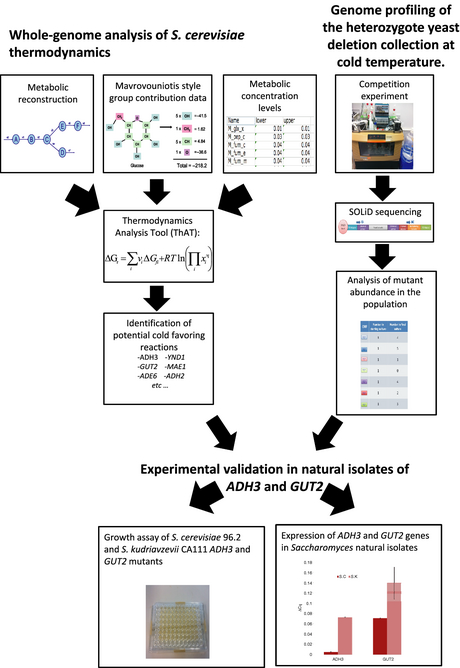Systems biology of cold-tolerant phenotype in Saccharomyces species
Temperature is one of the leading factors that drive adaptation of organisms and ecosystems. Remarkably, many closely related species share the same habitat because of their different temporal or micro-spatial thermal adaptation. In this study, we seek to find the underlying molecular mechanisms of the cold-tolerant phenotype of closely related yeast species adapted to grow at different temperatures, namely S. kudriavzevii CA111 (cryo-tolerant) and S. cerevisiae 96.2 (thermo-tolerant). Using two different systems approaches, i. thermodynamic-based analysis of a genome-scale metabolic model of S. cerevisiae and ii. large-scale competition experiment of the yeast heterozygote mutant collection, genes and pathways important for the growth at low temperature were identified. In particular, defects in lipid metabolism, oxidoreductase and vitamin pathways affected yeast fitness at cold. Combining the data from both studies, a list of candidate genes was generated and mutants for two predicted cold-favouring genes, GUT2 and ADH3, were created in two natural isolates. Compared with the parental strains, these mutants showed lower fitness at cold temperatures, with S. kudriavzevii displaying the strongest defect. Strikingly, in S. kudriavzevii, these mutations also significantly improve the growth at warm temperatures. In addition, overexpression of ADH3 in S. cerevisiae increased its fitness at cold. These results suggest that temperature-induced redox imbalances could be compensated by increased glycerol accumulation or production of cytosolic acetaldehyde through the deletion of GUT2 or ADH3, respectively.

Downloads
- Complete list of Gibbs energies of reactions in the iMM904 S. cerevisiae model at different temperatures
- Comparison of Gibbs energies of reactions calculated at low and high metabolite concentration for cold and warm temperature
Reference
Paget CM, Schwartz JM, Delneri D (2014). Environmental systems biology of cold-tolerant phenotype in Saccharomyces species adapted to grow at different temperatures. Molecular Ecology 23: 5241-57.
PubMed | Full text